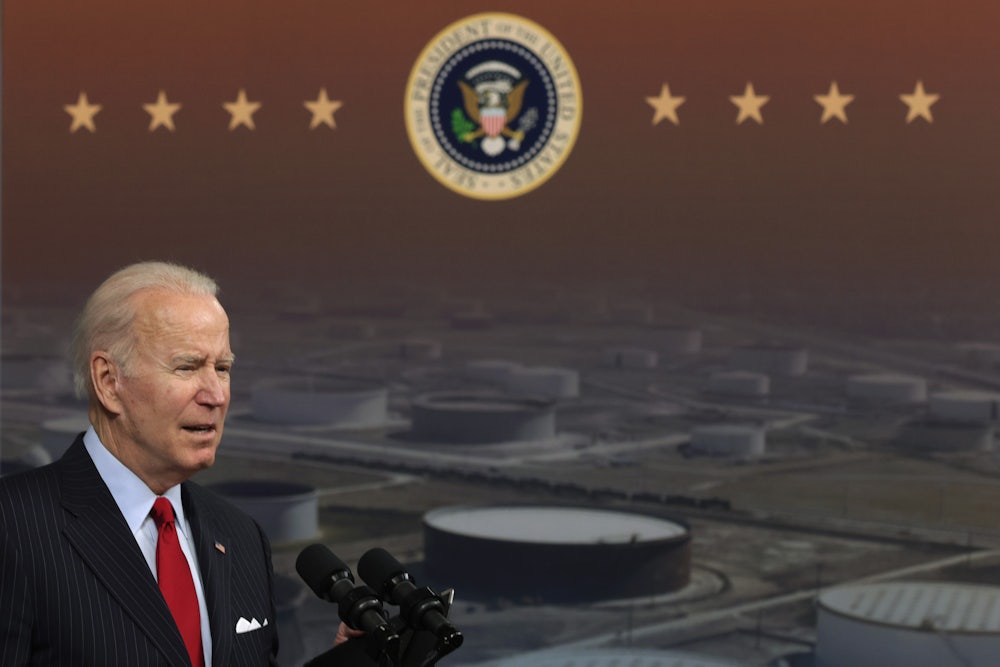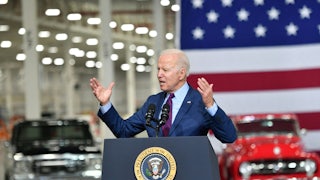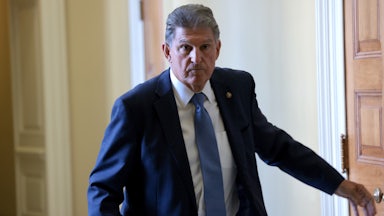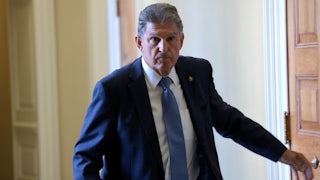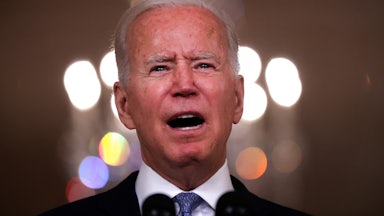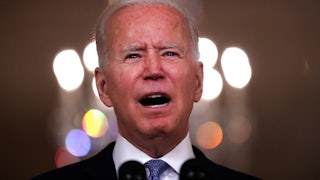The Biden administration is treating rising energy prices with more urgency than the climate crisis. After encouraging OPEC to drill more over the last few weeks, Biden on Tuesday announced that he’ll release 50 million barrels of crude oil from strategic reserves—the largest ever such drawdown, and only the second time reserves have been used to influence gas prices, up 60 percent over a year ago. The move comes amid broader concerns about rising inflation, and on the tail of the administration having spent two weeks talking up his administration’s climate leadership credentials at UN climate talks in Scotland.
There’s an obvious contradiction between these two goals: Biden cannot move heaven and earth to keep gas prices permanently cheap while claiming he’s committed to capping global warming at 1.5 degrees Celsius. The latter requires keeping fossil fuels in the ground. The former entails drilling much more of them.
Yet despite this structural tension, some of the tools for addressing inflation and for decarbonizing are related. While policymakers in the last few decades have frequently relied on blunt force policies such as interest rate hikes and carbon prices to accomplish climate or monetary policy goals, respectively, that consensus seems to be changing. And as Biden’s quest for cheap gas shows, those two conversations can’t continue to exist in separate silos. Policymakers will need a large toolbox to handle the ups and downs of a dynamic economy as it prepares, optimistically speaking, for its most ambitious undertaking to date: tackling the climate crisis by getting off of fossil fuels.
The fossil fuel industry and its allies often suggest that climate policies are responsible for driving prices higher, pushing hardworking American families to the brink of financial ruin. That’s not the case: Gas prices are higher than they were, but still lower than averages throughout the 2000s. Constraint among drillers eager to get back in the good graces of their investors is a far bigger driver of pain at the pump than non-existent green energy policy.
“The energy transition will make our inflation problems a lot more manageable. What people really have not gotten their heads around is how much of the inflation we’re seeing now is driven by energy,” said J.W. Mason, an economist at John Jay College, City University of New York. Clean energy is much less economically volatile than fossil fuels, and its ever-declining costs aren’t prone to the same boom and bust cycles that have defined the age of oil. “If you remove our reliance on fossil fuels you remove the biggest source of inflation in the economy,” Mason told me.
Energy-driven inflation isn’t unique to the post-Covid moment, of course. The near exhaustion of the United States’ conventional oil reserves at the start of this century led to inflation that was credited as a contributing factor to the Great Recession, and the defining image of inflation in the 1970s was long lines for gasoline. In the latter case the Nixon and Carter administrations unveiled a suite of sector-specific policies aimed at boosting domestic energy supplies, including (in Nixon’s case) banning crude oil exports and, in Carter’s, boosting both coal production and research into renewables.
It’s relatively rare for inflation to affect prices across the board. The extent to which energy is heavily weighted within the basket of goods used to calculate the Consumer Price Index means it plays an outsized role in determining whether goods are getting more expensive in general. That’s coupled with the fact that Americans are more intimately acquainted with gas prices than that of almost any other commodity. “On the side of the road all across America the price day to day is posted and then changed, so there’s just enormous sensitivity to it,” Roosevelt Institute Director of Governance Studies Todd Tucker told me over the phone.
But even though inflation tends to affect certain goods and leave others alone, the response to it for years has been a blunt force instrument: If prices start getting too high, then regulators shock the economy into the gutter by moving to raise interest rates. That will drive down business investment, thus shrinking the number of jobs available and putting unruly workers demanding higher wages in their place, ending the dreaded “wage-price spiral.” People might struggle and starve—inordinately people of color—but the fundamentals of the economy will look stronger on paper, and desperation will create a cheaper and more compliant workforce with which to welcome private investors.
It wasn’t always the case that governments responded to inflation by wrecking the economy. To run the wartime economy in the 1940s, for instance, the now-defunct Office of Price Administration employed some 160,000 people tasked with making sure that a red hot full employment economy wouldn’t make necessities like food and fuel unaffordable for ordinary people as the government procured scores of both. Price controls, Tucker explains in a new report, were part of a suite of economic planning tools used to prevent profiteering on certain in-demand goods.
“In the past when we’ve frozen and unfrozen the economy—converting from war use to civilian use—policymakers have taken to the idea that, with that kind of dislocation, price controls are an appropriate tool so that you’re keeping prices within a rough estimate of what they were pre-conversion,” Tucker told me.
It makes sense that the post-Covid-shutdown economy is going through a readjustment period, Tucker added. “We’re calling this a crisis when in reality it’s a return to normal after a freezing of the economy.”
Neither sectoral planning nor price controls are novel concepts in the United States, as Tucker points out. Yet it is now almost unfathomably difficult to imagine our government carrying out the tasks it once did before cell phones or the internet. Nonetheless, the sorts of innovative state policy that was instrumental in carrying out the wartime mobilization is exactly what’s needed to drive the energy transition—a shift that will affect all parts of the consumer and industrial economy. “The range of tools in the toolkit is sometimes smaller than it needs be,” Tucker said. “Direct public provision of goods, price controls—there is a whole range of things where you can use state power more directly rather than trickle it down through firms.”
What all nearly all the flashy net-zero pledges unveiled in the last few years have in common is that they assume the private sector will be the dynamic engine of the energy transition, with governments acting as midwives to de-risk (read: make profitable) investment in everything from solar power to seawalls. This represents, in some sense, a welcome turn away from treating carbon pricing as the be-all-end-all of the climate policy toolkit; climate change is an investment problem now. Yet policymakers’ vision remains frustratingly narrow: The aim of green public policy, according to this line of thinking, is still—as economist Daniela Gabor has argued—to catalyze private investment in low-carbon technologies. Pouring enough money into renewables through incentives like tax credits will enable them to outcompete fossil fuels on a free and open energy market, without the need to constrain production through regulations. Shiny new asset classes will arise to properly value nature and stop the destruction of the Amazon. Private finance will transform modest public R&D spending into an unprecedented capacity to profitably suck carbon out of the atmosphere and industrial processes.
The problem with this vision is that climate change is primarily a planning problem, not a technological one. We already have the technology we need to decarbonize huge sections of the economy. But without a broader toolkit to handle dislocations and divestments, the decarbonization upheaval will make the current Covid-era disruption look mild. And leaving the management of that upheaval to the private sector risks not only logistical challenges—the private sector is prone to make bad investment decisions—but political backlash, ceding key decisions about the transition up to actors whose only legal responsibility is to make a profit.
The Roosevelt administration’s wartime mobilization, after all, didn’t just build ships and weapons: It also laid out tools to insulate people from the anticipated and unanticipated effects of the state doing a lot of novel things very quickly, including when life readjusted to a new normal. Following that model in even modest ways could, in the short term, mean responding to high heating costs by plowing money into the Low-Income Home Energy Assistance Program (LIHEAP). It might also mean reinstating the crude oil export ban, to both lower oil prices at home and discourage production now taking place mainly to pad the pockets of fossil fuel executives.
A concerted push to electrify everything as the world continues to warm will bring with it a lot of volatility, albeit orders of magnitude less volatility than unchecked climate change would bring. Prices for so-called “critical minerals” needed to power electric vehicles—like lithium and cobalt—are already spiking, with shortages expected within the next five years. Trillions of dollars worth of fossil fuel investments will become unprofitable to extract and sell. Rising temperatures could lead to drastic declines in crop yields, and the effects of climate change are already driving up global food prices. Governments can hope the private sector will sort out the enormous logistical and equity questions the twenty-first century is already raising, coaxing private investments along by making the public sector shoulder the risk. Or they can start planning for changes on the horizon.
